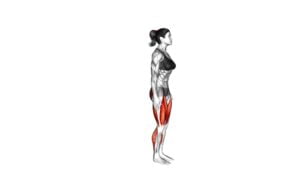Jumping Single Leg Lunge – Video Exercise Guide & Tips

Are you looking for a challenging leg exercise that will take your fitness to the next level? Look no further than the Jumping Single Leg Lunge!
Watch This Exercise Video
This dynamic movement targets your quads, glutes, and core, giving you a full-body workout.
In this video exercise guide, we'll show you the proper form and technique, as well as modifications for beginners and advanced variations.
Get ready to jump into action and achieve maximal results with this effective exercise.
Key Takeaways
- The Jumping Single Leg Lunge targets quads, glutes, and core, effectively activating and strengthening these muscle groups.
- Beginners can modify the exercise by using support for balance, reducing range of motion, and focusing on maintaining proper form.
- Advanced variations of the exercise, such as incorporating plyometric jumps, can increase power, strength, stability, and cardiovascular endurance.
- To maximize results, increase intensity, focus on progression, perform advanced variations, and maintain proper form.
Benefits of the Jumping Single Leg Lunge
You will experience numerous benefits from incorporating the jumping single leg lunge into your workout routine. This exercise is highly effective for muscle activation, particularly targeting the muscles in your legs, glutes, and core. By performing the jumping single leg lunge, you engage your quadriceps, hamstrings, and calves, helping to strengthen and tone these muscle groups. Additionally, the explosive nature of the jump increases the intensity of the exercise, leading to greater cardiovascular benefits.
The jumping single leg lunge is a dynamic movement that requires coordination and balance. As you lunge forward and jump off one leg, you activate your stabilizer muscles, enhancing your overall balance and proprioception. This exercise also improves your agility and coordination, as you move through the sequence of lunges and jumps.
In terms of cardiovascular benefits, the jumping single leg lunge increases your heart rate and helps improve your cardiovascular endurance. By incorporating explosive movements into your workout routine, you can elevate your heart rate and challenge your cardiovascular system, ultimately leading to improved stamina and endurance.
Incorporating the jumping single leg lunge into your workout routine can be a valuable addition to your fitness regimen. With its focus on muscle activation and cardiovascular benefits, this exercise can help you achieve your fitness goals, whether you're looking to build strength, enhance endurance, or improve overall athleticism.
Proper Form and Technique
To ensure proper form and technique for the jumping single leg lunge, focus on maintaining a stable and balanced position throughout the exercise. Proper alignment is key to avoid common mistakes and maximize the effectiveness of this exercise.
Start by standing with your feet hip-width apart and your core engaged. Take a step forward with one leg and bend your knee to approximately 90 degrees, keeping your knee aligned with your toes. Your back leg should be straight, with your heel lifted off the ground.
As you lower into the lunge, make sure your front knee doesn't extend past your toes. This can put unnecessary strain on your knee joint. Keep your torso upright and avoid leaning forward or backward.
To perform the jumping motion, push off with your front foot, exploding upward into the air. Switch legs mid-air and land softly with the opposite leg forward. Repeat the exercise on the other side.
Remember to maintain proper alignment and control throughout the entire movement. This will help prevent injuries and ensure you're engaging the correct muscles.
Now that you understand the proper form and technique of the jumping single leg lunge, let's move on to modifications for beginners.
Modifications for Beginners
For beginners, a helpful modification to consider for the jumping single leg lunge is to perform the exercise with a support or assistance. This modification can help you maintain balance and stability as you work on building strength and coordination. One common challenge for beginners is maintaining proper form throughout the movement. By using a support or assistance, such as a chair or wall, you can ensure that you have something to hold onto if you start to lose your balance. This will allow you to focus on performing the exercise correctly and engaging the correct muscles without the fear of falling.
Another modification for beginners is to reduce the range of motion. Instead of lunging deeply, you can start with smaller movements and gradually increase the depth as you gain strength and confidence. This will help you gradually build up the necessary strength in your legs and core to perform the exercise with full range of motion.
Advanced Variations to Take It up a Notch
To challenge yourself further, incorporate plyometric jumps into the single leg lunge. Plyometric lunges are explosive leg exercises that can take your workout to the next level. By adding a jump to the single leg lunge, you engage more muscles and increase the intensity of the exercise.
To perform a jumping single leg lunge, start by standing with one foot forward and the other foot back in a lunge position. Lower your body into a lunge, keeping your front knee in line with your ankle. As you push back up, explode off the ground and switch your legs in mid-air, landing softly with the opposite leg forward. Repeat the movement, alternating legs with each jump.
The plyometric nature of this exercise helps improve power, strength, and stability in your lower body. It also increases your cardiovascular endurance, making it a great addition to any high-intensity workout routine.
Remember to maintain proper form throughout the exercise. Keep your chest up, core engaged, and land softly to protect your joints. Start with a low number of repetitions and gradually increase as you build strength and confidence.
Incorporating plyometric jumps into your single leg lunges will challenge your muscles in new ways and take your fitness level up a notch. Give it a try and feel the burn!
Tips for Maximal Results
Maximize your results by following these tips:
- Increase the intensity: Intensity matters when it comes to seeing significant results from your workouts. By pushing yourself to your limits and challenging your muscles, you can stimulate growth and improve your overall fitness level. Incorporate explosive movements, such as the jumping single leg lunge, to increase the intensity of your workouts and maximize your results.
- Focus on progression: Progression is key to achieving maximal results. Gradually increase the difficulty of your workouts by adding more weight, increasing reps, or performing advanced variations of exercises. This constant challenge keeps your muscles guessing and prevents plateaus. Consider incorporating different variations of the jumping single leg lunge, like adding a plyometric jump or using dumbbells, to continually progress and see greater results.
- Maintain proper form: It's crucial to maintain proper form throughout the exercise to ensure that you're targeting the right muscles and avoiding injury. Keep your core engaged, chest up, and knees aligned with your toes during the jumping single leg lunge. This ensures that you're effectively working your glutes, quads, and hamstrings while minimizing the risk of strain or injury.
- Listen to your body: Pay attention to your body's signals and adjust your workouts accordingly. If you feel any pain or discomfort, modify the exercise or take a break. Pushing through pain can lead to injury and hinder your progress. It's important to challenge yourself, but also to listen to your body's limits and give yourself time to recover.
Precautions and Common Mistakes to Avoid
Be mindful of potential pitfalls and errors to steer clear of when performing the jumping single leg lunge. This exercise can be highly effective in targeting your lower body muscles and enhancing your overall strength and stability. However, it's important to take certain precautions to ensure you perform it safely and accurately.
Firstly, always warm up before attempting the jumping single leg lunge. This will help prepare your muscles for the intensity of the exercise and reduce the risk of injury. Additionally, make sure you have enough space around you to perform the exercise without any obstructions. Clearing the area will prevent accidents and allow you to fully engage in the movement.
One common mistake to avoid is overextending your knee. When performing the lunge, make sure your knee remains aligned with your ankle and doesn't go beyond your toes. This will help protect your knee joint and prevent unnecessary strain.
Another common mistake is rushing through the exercise. Remember to maintain control and perform each repetition with proper form. This will maximize the benefits of the exercise and minimize the risk of injury.
Lastly, always listen to your body and stop if you experience any pain or discomfort. It's important to know your limits and gradually increase the intensity of the exercise over time.
Frequently Asked Questions
How Many Calories Does the Jumping Single Leg Lunge Burn?
Incorporating jumping exercises into your workout routine can provide numerous benefits, including increased calorie burn.
The jumping single leg lunge is an effective exercise for torching calories.
To perform it properly, start by standing with one leg forward and the other leg extended behind you.
Jump up, switching legs mid-air, and land in a lunge position with the opposite leg forward.
Repeat this movement for maximum calorie burn and leg strengthening.
Can the Jumping Single Leg Lunge Help Improve Vertical Jump Height?
The jumping single leg lunge is a plyometric exercise that can help improve your vertical jump height. By incorporating explosive power and engaging the muscles in your legs and core, this exercise can enhance your ability to generate force and propel yourself off the ground.
Plyometric exercises, like the jumping single leg lunge, are known for their benefits in increasing power, speed, and overall athletic performance. So, if you're looking to elevate your vertical jump, this exercise is a great addition to your training routine.
Will the Jumping Single Leg Lunge Target Specific Muscles in the Legs?
The jumping single leg lunge is a great exercise for targeting specific muscles in your legs. By performing this exercise, you can activate and strengthen your quadriceps, hamstrings, glutes, and calf muscles.
This muscle activation can lead to improved strength, power, and stability in your legs. However, like any exercise, there are also potential drawbacks. It's important to maintain proper form and listen to your body to avoid strain or injury.
Can the Jumping Single Leg Lunge Be Included in a Circuit Training Routine?
Yes, you can definitely include the jumping single leg lunge in a circuit training routine. It's a great exercise to incorporate into a HIIT (High-Intensity Interval Training) workout.
The jumping single leg lunge targets specific muscles in the legs, such as the quadriceps, hamstrings, and glutes. By including this exercise in your circuit training routine, you can improve your leg strength, power, and overall cardiovascular fitness.
It adds variety and intensity to your workout, making it more challenging and effective.
Are There Any Variations of the Jumping Single Leg Lunge That Require Equipment?
Yes, there are variations of the jumping single leg lunge that require equipment.
These variations can add an extra challenge to your workout.
Some examples include using dumbbells or kettlebells to increase the resistance, or using a plyometric box to jump onto after completing the lunge.
Incorporating equipment into your jumping single leg lunges can help to target different muscle groups and make your workout more dynamic and intense.
Conclusion
In conclusion, the jumping single leg lunge is a highly effective exercise that targets the lower body muscles while also improving balance and coordination.
By following proper form and technique, individuals can maximize the benefits of this exercise. Beginners can start with modifications and gradually progress to advanced variations for a greater challenge.
Remember to listen to your body, avoid common mistakes, and consult a professional if needed.
Incorporating this exercise into your fitness routine can lead to impressive results.

Author
Years ago, the spark of my life’s passion ignited in my mind the moment I stepped into the local gym for the first time. The inaugural bead of perspiration, the initial endeavor, the very first surge of endorphins, and a sense of pride that washed over me post-workout marked the beginning of my deep-seated interest in strength sports, fitness, and sports nutrition. This very curiosity blossomed rapidly into a profound fascination, propelling me to earn a Master’s degree in Physical Education from the Academy of Physical Education in Krakow, followed by a Sports Manager diploma from the Jagiellonian University. My journey of growth led me to gain more specialized qualifications, such as being a certified personal trainer with a focus on sports dietetics, a lifeguard, and an instructor for wellness and corrective gymnastics. Theoretical knowledge paired seamlessly with practical experience, reinforcing my belief that the transformation of individuals under my guidance was also a reflection of my personal growth. This belief holds true even today. Each day, I strive to push the boundaries and explore new realms. These realms gently elevate me to greater heights. The unique combination of passion for my field and the continuous quest for growth fuels my drive to break new ground.







